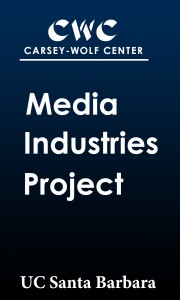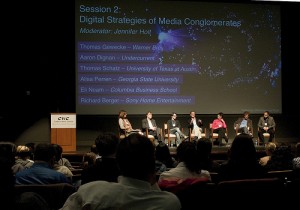What is MIP?
 The Media Industries Project (MIP) examines the rapid and dramatic changes affecting the media industries worldwide, focusing especially on globalization, digitization, and creative labor. As a research program of the Carsey-Wolf Center at UC Santa Barbara, we generate a range of critical analyses and innovative resources in collaboration with industry practitioners, policy experts, and media industries scholars. Our publications and events all target key industry concerns but generate insights market research firms and trade magazines are less willing to explore. In short, our perspective contextualizes developments in more critical frameworks, drawing attention to the cultural, economic, and political ramifications of change in the global media landscape.
The Media Industries Project (MIP) examines the rapid and dramatic changes affecting the media industries worldwide, focusing especially on globalization, digitization, and creative labor. As a research program of the Carsey-Wolf Center at UC Santa Barbara, we generate a range of critical analyses and innovative resources in collaboration with industry practitioners, policy experts, and media industries scholars. Our publications and events all target key industry concerns but generate insights market research firms and trade magazines are less willing to explore. In short, our perspective contextualizes developments in more critical frameworks, drawing attention to the cultural, economic, and political ramifications of change in the global media landscape.
Yet our raison d’être extends beyond the materials we create to include the manner in which we create them. This is a two-fold process. First, we put industry leaders in dialogue with scholars, both to expand the scope of information about media industries and to encourage more inventive thinking about the future of modern media. Accordingly, we’ve hosted or co-hosted events about digital distribution and the television series Law & Order. We also are collaborating with colleagues at the Carsey-Wolf Center and the Department of Film and Media Studies on an upcoming event about the social and cultural implications of half hour comedy. Each event offers a unique forum for industry leaders, policymakers, scholars, and journalists to bring their respective expertise to bear on a set of shared questions and concerns. Videos of these discussions are archived on our website as a public resource for researchers and teachers.
Second, and similarly, we try to transgress distinct boundaries in our writing—addressing our publications to readers in the industry, the classroom, and the research library. We strive to enhance public awareness of the issues, challenges, and operations of the media industries as much as we aim to become the institutional home for media industries research. With everything we do, our objective is to remain authoritative yet accessible, critical yet concise.
Our most popular feature is the interview section, where we publish transcripts of our conversations with industry leaders. So far, most of these interviews have focused on the impact of the digital distribution revolution on the television and film industries. We’ve interviewed Gary Newman, Betsy Scolnik, and Jordan Levin, among others, each offering a distinct perspective on how emergent technologies affect his or her decision-making processes.
More than “insider opinions,” these conversations generate an intellectual space in which our industry collaborators step outside day-to-day pressures to speculate about the media industries of tomorrow. Just as importantly, the interview archive facilitates access to perspectives often unavailable to media industries researchers, teachers, and students.
Creating a knowledge base with the best material possible is a commitment to the field we take seriously, and the interview archive anchors a number of related offerings that we have subsequently rolled out.
In October, for instance, we launched a new series called The Buzz in which we distill media coverage of recent issues and events to its essence. It serves two purposes: to help busy executives cut through the clutter of repetitive news cycles and to provide scholars and students with a jumping off point for further research. In our companion series, Things to Know, we move past the headlines to place developments in a larger critical, historical, or theoretical framework. Our goal here is simple: to provide readers with comprehensive analyses in a lively, straightforward style.
In February, we debuted another new series called The Bookshelf in which we periodically feature notable book-length contributions to the field of media industry studies. It joins our quarterly guide to recently published scholarly essays and journal articles, From the Field. As a growing collection of media industries research, both series are invaluable resources for the discipline.
Dialogue and accessibility, then, are the cornerstone to our overall operating logic, as we try to transcend some of the constraints of conventional scholarly publishing. We’re aiming for a nimble format that allows us to respond to developments as they arise and one that’s open to alternative modes of address.
In that same pioneering spirit, we recently launched a large-scale “connected viewing” research initiative in collaboration with Warner Bros. Digital Distribution. The project brings together eleven research teams from different parts of the world to explore the ways social networking, multi-screen exhibition practices, and digital distribution are upending traditional business strategies and viewing behaviors. As the industry grapples with unprecedented shifts in the home entertainment marketplace, the Connected Viewing Initiative puts us at the forefront of those changes. While each research team will conduct an independent project of its own, our collective efforts will establish a starting point for the field to debate the value of connected content in an era of digital delivery.
Similarly, we are preparing to launch another major research initiative in Afghanistan, where, since 2004, a lively young television industry has coalesced to provide programming in a range of genres. It’s quickly becoming the country’s medium of choice. We’ve begun fundraising for a project that will study the industry leader, Tolo TV, and its output, some 40,000 hours of programming, which we’ll digitally archive and analyze. We hope both to understand the industrial logic of Afghan television and the cultural trends that are manifested in its programming, especially with respect to gender, politics, and human rights. The archive will serve as the foundation for a series of events, conferences, curriculum, and outreach activities, both in Santa Barbara and Kabul, that will provide a more thorough understanding of the vital role television plays in the cultivation of social change in developing societies.
A final point: we’re growing, rapidly. We have many more exciting efforts planned for the future, including a global collaboration to publish an online peer-reviewed journal dedicated exclusively to media industries research. So, in the spirit of collaboration and conversation that runs through everything we do at MIP, please, stay tuned, and if you’re interested, get involved. We’d love to hear from you.


